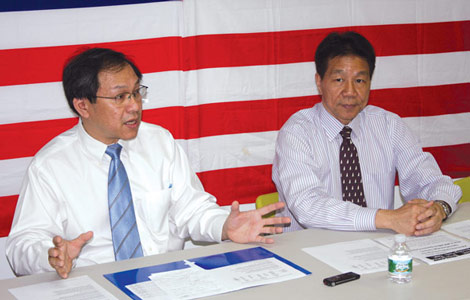US hay helping China's dairy needs
Updated: 2014-06-16 11:59
By Jack Freifelder in New York (China Daily USA)
|
||||||||
As China continues to reach out for potential feed supplies to meet the needs of its growing dairy market, the practicality of importing hay feed from the US continues to improve, according to two California-based exporters.
And now US farmers and exporters of alfalfa hay in particular are starting to reap the benefits.
"I think the growth in China has been anticipated," said Greg DeWitt, manager of marketing and communications for ACX Pacific Northwest, a California-based hay exporter. "Alfalfa is the very beginning of so many products, not just milk but cheese, ice cream, yogurt," DeWitt said. "A lot of people may not realize that alfalfa is just a base for that."
Over the last decade, DeWitt said exports "grew exponentially" from ACX's operations in the US to China, due in part to the "interest and awareness around alfalfa".
There has been a steady increase in demand for hay products around the world, "not just in China", DeWitt said.
California produced 6 million tons of alfalfa hay last year, and sales of alfalfa shipped abroad in 2013 totaled $586 million, according to the Los Angeles Times.
"China has little choice but to turn to US farmers to help supply feed for the country's growing herd of dairy cows," the Times report said. "Packed with fiber and protein, alfalfa hay is considered the gold standard for forage, and since 2009, US alfalfa exports to China grew nearly eightfold to a record 575,000 tons."
China is now Asia's biggest buyer of US alfalfa, as well as the biggest global destination for US food and agricultural products, according to the US Department of Agriculture (USDA).
China, which accounts for nearly 20 percent of all US farm exports - a total that reached $144 billion in 2013, is already a large buyer of corn, cotton, soybeans and wheat from the US.
Agricultural exports from the US to China reached $26.7 billion in 2013.
"The [Chinese] government policy is to increase milk production, and in order to do that, they need high quality forage," said Dan Undersander, a forage agronomist at the University of Wisconsin's forage research and extension. "Our advantage has been consistent, high quality hay, but the other advantage is it's very inexpensive to ship hay to China."
Undersander, who has worked in China, said he's "not surprised at all" by China's interest in US forage.
"To the extent that the policy is to continue to encourage dairy production in China, there will be a significant need for alfalfa," he said.
California is the biggest agricultural state in the US, responsible for close to half the fruits, nuts and vegetables grown in the US. And hay is among the top 10 commodities the state produces, according to the California Department of Food and Agriculture (CDFA).
"China seems to be on this growth approach, growing each year steadily, which really helps the industry evolve and develop at a much stronger pace," said Adam Lyerly, an export sales manager with El Toro Export LLC in El Centro, California. "I give kudos to the US Forage Export Council (USFEC)."
The USFEC, an organization of roughly 30 different forage export companies from California, Idaho, Oregon and Washington state, is a group that focuses on "common trade goals" and "like-minded issues," Lyerly said Friday in an interview with China Daily.
Both El Toro Export and ACX Pacific Northwest are members of the USFEC.
"We want those that are using our products, especially our Chinese customers, to understand that forage products coming from USFEC member companies are of good quality that can be continually counted on," Lyerly said. "Our goal is to have our brand come across as something people can rely on, and we continue to take that approach in our business in China."
(China Daily USA 06/16/2014 page3)

 Congresswoman questions US 'pivot' strategy
Congresswoman questions US 'pivot' strategy
 Neil Bush: Continuing a father's legacy
Neil Bush: Continuing a father's legacy
 Beijing, Hanoi vow to act on friction
Beijing, Hanoi vow to act on friction
 Coalition to host forum over NYC school admissions bill
Coalition to host forum over NYC school admissions bill
 Chinese tycoon offers free lunch, cash to poor in NYC
Chinese tycoon offers free lunch, cash to poor in NYC
 NYC business professionals earn a salute
NYC business professionals earn a salute
 Chinese football fan at Maracanã Stadium
Chinese football fan at Maracanã Stadium
 High-level exchange
High-level exchange
Most Viewed
Editor's Picks

|

|

|

|

|

|
Today's Top News
Greek PM salutes 'a game changer'
Hainan expands US presence to Boston
US to send 300 military advisers to Iraq
Evacuation plans made for Chinese workers in Iraq
Evacuation plans made for Chinese workers in Iraq
US citizens arrested on terror charges
Bomb plot defendant denied files by court
Rare stamp sets record at New York auction
US Weekly

|

|







